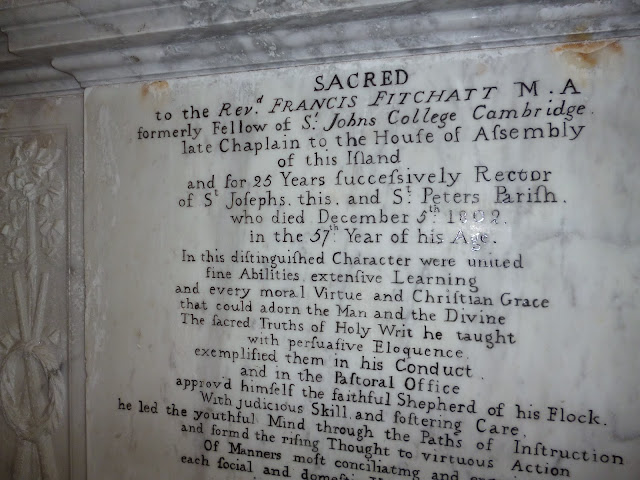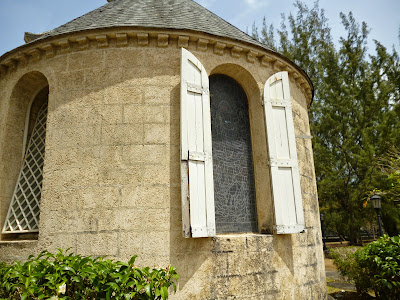Our island is blessed with a large number of beautiful old churches.
St. James Anglican Parish Church
The Oldest Church in Barbados
Established 1628
To be a beacon radiating God's love, among all people.
It
is one of the four oldest surviving churches on the island and stands
on one of the oldest pieces of consecrated land on the island, also
known as "God's acre."
It is located near the site of the island's first settlement of the English who arrived on February 17, 1627. As the settlement rapidly grew, it became necessary to erect a place of worship, and so a wooden Anglican church was built in 1628.
It was later
replaced by a coral stone structure in 1680 after a hurricane destroyed
much of the island. When the walls of the coral stone building began to decay after nearly 200 years, they
were partly demolished and replaced by a larger, more substantial
structure in 1874...the nave roof was raised on new pillars and
arches.
The enlarged building was consecrated by Bishop Mitchinson
on Easter Tuesday, 1875.
With the exception of the sanctuary and the north porch, added in the 1900's this is basically the same building in use today.
The Baptistery
Located on the ground floor of the belfry in the southern entrance is the original Baptismal Font dated 1684.
The font is over 300 years old.
It was donated by Richardus Walter....the inscription reads: "Debit Richardus Walter to the Church of St. James Anno 1684."
Also located in the Baptistry is a beautiful stained glass window depicting the baptism of the Ethiopian Eunuch by St. Philip on the road from Jerusalem (Acts Ch.8 v.26-40)
This window is two and a half feet wide by seven feet tall
with a half-round top and faces east.
It shows two figures surrounded by lush landscape, seaside, palm trees and vegetation with an ornate floral pattern surrounding the main figures, while another figure in the background astride a donkey can be seen observing the baptism.
The plaque below is inscribed, "In affectionate memory of John Bishop Culpepper, Captn.
14th Dragoons,
of Easy Hall, in this Island, who died January 3rd, 1875. Erected by his
Widow."
The Lady Chapel
A gorgeous chandelier adorns the ceiling...this photo does not do it justice.
Lady Chapel Garden Window
 From the church website:
"This stained glass was installed in the organ apse window of the St.
James Parish Church in thanksgiving for the $3/4 million restoration
and was dedicated on November 10th, 1991.
It is an unusual window, two and a half feet wide by seven feet
tall, with a half-round top. The frame is cast-iron and inch-wide
muntins of the same iron criss-cross it diagonally, forming in the main,
4-3/4 "sqare lights". There are 104 of these, with 987 pieces of glass.
The motif, or central idea, is that of a garden's colour: the many
splendoured hues of tropical blooms, open sky and various greens and
browns of the foliage, branches and the earth intermingled with
water-visual expression of the life celebrated in the church.
The window was designed by Bill Grace and crafted by Ruth &
Jim Lambie. Engineers Michael Hatch and son Guy, installed the window."
From the church website:
"This stained glass was installed in the organ apse window of the St.
James Parish Church in thanksgiving for the $3/4 million restoration
and was dedicated on November 10th, 1991.
It is an unusual window, two and a half feet wide by seven feet
tall, with a half-round top. The frame is cast-iron and inch-wide
muntins of the same iron criss-cross it diagonally, forming in the main,
4-3/4 "sqare lights". There are 104 of these, with 987 pieces of glass.
The motif, or central idea, is that of a garden's colour: the many
splendoured hues of tropical blooms, open sky and various greens and
browns of the foliage, branches and the earth intermingled with
water-visual expression of the life celebrated in the church.
The window was designed by Bill Grace and crafted by Ruth &
Jim Lambie. Engineers Michael Hatch and son Guy, installed the window."
Intricate wood work adorns the sanctuary.
The organ console on the right.....the music is transmitted electrically to the pipes.
The Pulpit
Made from local mahogany, it was designed and built by John Edward Challenor and Wilfred Worrell in 1921.
The front pew is adorned with a commemorative plaque highlighting the visit of President Ronald Reagan and his wife Nancy to the church to attend Easter Sunday service on April 11th, 1982.
They were guests of their friend Claudette Colbert who lived on the island at the time.
President Reagan was the first sitting US president to visit the island.
The Altar Window
 From the church website
From the church website
Altar Window
"Known as the East Window, situated above the High Altar, it depicts The Ascension of Christ into heaven before his disciples. The disciples are clustered around below Christ while the
kingdom of heaven opens above His head. God's glory shines down in
golden rays as He is lifted into the clouds and also takes the shape of
an inverted shell. The shell commonly represents St. James the Greater.
This window is a memorial to those who gave their lives for their
country in the Great War. Dedicated by Bishop Berkeley on November 11,
1924, it is inscribed, 'To the Glory of God and in Memoriam. 1914-1918'.
This window is two and a half feet wide by seven feet tall with a half
round top."
The Sanctuary and Choir Area
Several burial tablets adorn the church walls
Written in Olde English
In the northern porch of the church is the original 400 pound church bell with the
inscription - "God bless King William, 1696". This bell pre-dates the
famous American Liberty bell in Philadelphia, USA by 56 years and Big Ben, the Bell in the Clock Tower at Westminster Palace, London, by 162 years.
It fell from the belfry after 200 years of service and was badly cracked.
It was shipped to WhiteChapel Bell Foundry in the UK(*) for repairs and returned in 1889.
Although it was repaired, it cannot ring true.
(*) WhiteChapel Bell Foundry also made the famous Big Ben in London.
Due to its historic value, it has been retained and is therefore displayed as a monument in the northern porch.
A new bell was donated by a benefactor.
There are two bronze Bas Reliefs situated at the back of the church.
The plaque under the Bas Relief
The Hunger Veil
Ethiopian-style Hunger Veil Bible Stories in pictures was presented by Canon Andrew Hatch, former Rector.
The Church is a popular tourist attraction.
The pews are teak wood.
Standing under the organ looking up.
The inside is cool and serene thanks to the coral stone.
The Pipe Organ
With its beautiful hand-carved mahogany encasement.....it is approximately 130 years old.
The church's first organ was ordered and built by the English firm,
Hill & Son, at a cost of 320 pounds. After its arrival and assembly in January
1876, the first organist was Charles A. Greenidge and
the bellows blower, Reynold W. Gillman.
Over the years, this organ was
replaced with various upgrades until the
existing instrument was completely rebuilt from 2006–2007 and
rededicated in 2008. Some of the pipes and structure still date back
about one hundred years.
The organ has 2000 pipes.
Yes, the pipes are horizontally positioned.
I didn't take the photo upside down.
The roof beams with lights that look like lighted candles.
Beautifully carved coral stone pillars adorn the church.
The Devil's Gate
There is a popular legend attached to St.
James Church, this gate in the north wall surrounding the churchyard is
referred to as 'The Devil's Gate'.
It is opened about one hour before
service. When the bell is rung the Devil leaves the church by this gate,
and it is closed as the service is about to begin, so that the Devil is
excluded from the area. This must have been derived from the old belief
that church bells were rung to drive the devil out of the building.
The church is registered as a National Trust protected building.
The outside of the Altar window.
The gargoyle rain gutter down spout.
The circular bell tower
Many of the original settlers and prominent Barbadians were laid
to rest in the Church and its yard.
Amongst the old graves in the church yard one can find the earliest legible grave stone which is dated 1700, John Gibbs.
The original burial ground was closed in 1887.
A new modern cemetery is located nearby.
The Garden of Remembrance
Urns with ashes of loved ones are interred.
A beautiful church both inside and outside....I will be visiting again.


































































